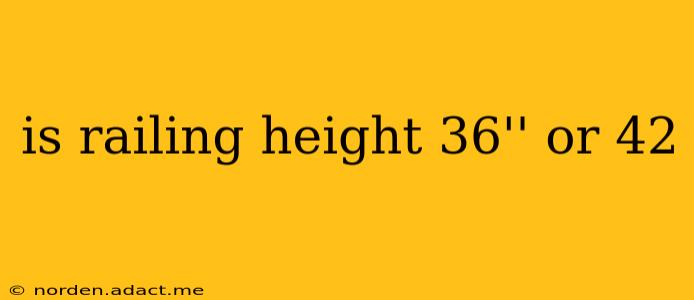Railing Height: 36 Inches or 42 Inches? It Depends!
The question of whether railing height should be 36 inches or 42 inches doesn't have a simple yes or no answer. The correct height depends on several factors, primarily the location and intended use of the railing. While both heights are common, understanding the regulations and best practices for different situations is crucial for safety and compliance.
What are the building codes for railing height?
Building codes regarding railing height vary depending on your location (country, state, and even local jurisdiction). However, generally, you'll find guidelines specifying minimum railing heights for different applications. These codes often distinguish between residential and commercial settings, and sometimes even consider the specific type of structure (e.g., stairs, balconies, decks). It's crucial to consult your local building codes and regulations before constructing any railing. Failing to meet these standards can result in fines or legal issues.
What is the difference between a 36-inch and a 42-inch railing?
The difference, simply put, is 6 inches. This seemingly small difference can significantly impact safety, particularly for certain populations. A 42-inch railing provides enhanced protection, especially for children and individuals who might be at higher risk of falling. The extra height offers a greater margin of safety, reducing the likelihood of a fall, even if someone were to lean or climb over the railing.
Are there any exceptions to the standard railing height requirements?
Yes, there can be exceptions, depending on the specific design and intended use of the railing. Some building codes might allow for variations based on factors like the surrounding environment, the potential for falls, and other safety measures in place. This is why consulting a qualified professional is so important; they can assess your specific situation and determine if any exceptions apply.
What are the typical applications for 36-inch and 42-inch railings?
While specific applications depend on local codes, here's a general guideline:
-
36-inch railings: Often sufficient for residential applications like decks and balconies where the fall hazard is relatively low and the user population is primarily adults. They are also commonly seen in commercial settings where the risk assessment deems them appropriate.
-
42-inch railings: Frequently required in situations with increased fall risk, such as railings around elevated walkways, stairwells, or in areas frequented by children. They are more commonly mandated in commercial settings where public safety is paramount.
How do I choose the right railing height for my project?
Choosing the right railing height involves a multifaceted process:
-
Consult local building codes: This is the single most important step. Understanding your local requirements is non-negotiable.
-
Assess the risk: Consider the height of the fall, the potential users (adults, children, elderly), and the overall environment.
-
Consult a professional: An architect, engineer, or qualified contractor can assess your specific situation and recommend the appropriate railing height and design.
By carefully considering these factors and adhering to local building codes, you can ensure that your railing provides the necessary level of safety and protection. Remember, safety should always be the top priority when choosing railing height.
